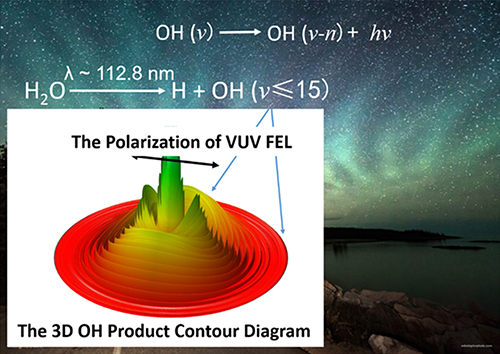The Earth's sky exhibits a faint luminescence known as airglow, which is caused by solar radiation initiated chemical reactions between atoms and molecules present in the upper atmosphere. The airglow provides important optical signatures of processes occurring in the atmosphere and studies of the airglow have driven the field of upper atmospheric science known as aeronomy.
OH Meinel band emission is an important contributor to the airglow in the Earth's mesosphere/lower thermosphere and has also been observed from the upper atmospheres of Mars and Venus.
More than 1700 OH Meinel lines have now been identified and assigned to transitions from high vibrational level of the ground state of the OH radical. Such vibrationally excited OH(X) radicals in the Earth's upper atmosphere have long been ascribed to products of the highly exothermic reaction of H atoms with O3.
The emission from OH radicals observed in the Earth's nightglow has been attributed to reactions involving vibrationally excited O3 molecules. However, it is challenged to study the OH dayglow.
Recently, Prof. YUAN Kaijun and Prof. YANG Xueming's group from the Dalian Institute of Chemical Physics (DICP) of the Chinese Academy of Sciences, in cooperation with Prof. Michael N. R. Ashfold from University of Bristol and Prof. John M. C. Plane from University of Leeds, revealed the production of the vibrationally excited OH from water photochemistry and its role in the hydroxyl dayglow emissions in the atmospheres of Earth and Mars.
The study was published in Journal of Physical Chemistry Letters on October 13.

Dalian coherent light source reveals water photolysis and its contributions to hydroxyl dayglow emissions in Earth and Mars atmospheres (Image by CHANG Yao)
H2O photolysis is an important source of OH radicals in the interstellar medium. The scientists studied the photodissociation of H2O around 112.8 nm by utilizing the vacuum ultraviolet Free Electron Laser together with the H atom Rydberg tagging time-of-flight technique.
The results revealed that the formation of extremely vibrationally excited OH(X, high v) fragments, with inverted vibrational state population distribution, maximizes at v=9 and extends to at least v = 15.
Atmospheric chemistry modeling predicted that these OH(X, high v) radicals might be detectable in the OH Meinel band dayglow in the upper atmosphere of Earth and might dominate the corresponding emission from the Martian atmosphere.
Further, OH(A) emission was shown to be an indicator of H2O photolysis in the upper atmosphere of Earth and, more importantly, the OH(X, high v)/OH(A) emission ratio might be a direct diagnostic of the oxidation state of exoplanetary atmospheres.
This study was supported by the National Natural Science Foundation of China, the Strategic Priority Research Program of the Chinese Academy of Sciences, the Chemical Dynamics Research Center, and the international partnership program of Chinese Academy of Sciences. (Text by CHANG Yao)